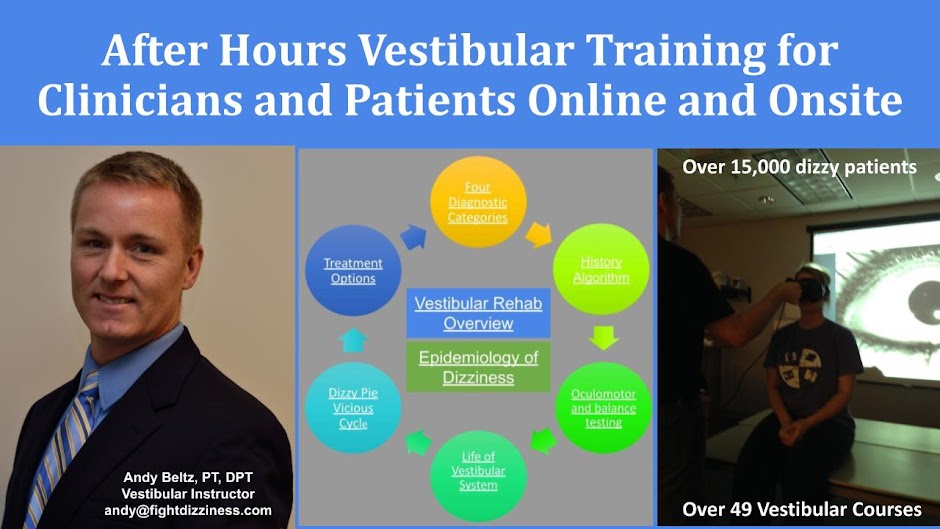For 20 years, I have included specialized forms of neck therapy as one of the main treatment modalities for many clients with dizziness and balance disorders. I have observed that these patients, who receive neck therapy, often improve faster than those receiving vestibular rehabilitation (VR). Also, I have noted progress in clients battling dizziness which was not improving with VR only but made progress once I added neck therapy to their plan of care. In this paper, I propose that specialized neck therapy is a form of priming for many clients battling dizziness and list treatment examples.
Various hypotheses exist for why neck therapy helps clients with dizziness. One potential explanation is that cervical spine treatment addresses proprioceptive and kinesthetic mismatched signals from weak/tight suboccipital muscles, weak deep neck flexors, and/or poor cervical joint alignment1-6. I also hypothesize that improvement is because neck therapy promotes parasympathetic nervous system activity. I believe increased parasympathetic nervous system activity balances the often heightened sympathetic state of being in which many people battling chronic dizziness exist. In my opinion, neck therapy is a form of neurologic priming that facilitates an optimal balance between parasympathetic and sympathetic activity needed to promote central vestibular compensation.
Priming is a fascinating theory. According to Stoykov and Madhavan7, priming promotes change by targeting neural mechanisms needed to promote progress in function. It is a form of “implicit” learning that does not require repetition. It generates an implicit memory that remains. It has the capability of both increasing (excitation) and decreasing (disinhibition) neuronal activity that is needed to acquire new skills. The terms “homeostatic plasticity” and “gating” are used to describe these phenomena. Gating would be utilized if too much inhibition impedes progress, and excitation would be used if a lack of neural excitability was present. Stoykov and Madhavan list five major methods of motor cortex priming:
- stimulation-based priming
- motor imagery and action observation
- manipulation of sensory input
- movement-based priming
- pharmacology-based priming
I would like to list various forms of neck therapy I use with many of my clients battling dizziness and balance disorders below with my belief on the likely corresponding form of motor cortex priming:
I regularly use neck therapy with my clients to manipulate the sensory input to their brains. Not only does the sense of neck movement prepare the brain for learning, but it decreases pain and the sense of tightness. Simultaneously, promoting increased mobility helps the brain re-organize the perception of normal for the skull on the spine. I hypothesize that it can also excite neuronal plasticity through AROM, strengthening, joint mobilization, and other forms of manual therapy. I believe this is also accomplished through targeted proprioceptive and kinesthetic sensory training at the level of the occiput and C1/C2 segments through laser biofeedback. Laser biofeedback adds visual stimulation, which may serve as an additional source of priming through sensory input.
Visual stimulation for motor imagery and action observation during neck therapy warrants attention. I often include relaxing youtube videos with beautiful scenic moving images and pleasant calming music during neck therapy. This may assist central vestibular compensation through motor imagery and action observation.
Finally, As noted in Stoykov and Madhavan’s article, the order of priming activities is important in the direction of stimulation. I often implement neck therapy before non-repositioning forms of vestibular rehab. Providing neck therapy before vestibular rehabilitation that is more aggressive allows the brain to prepare for new movement patterns to influence reorganization.
“I attest that this submission represents my own work and is compliant with Arcadia’s standards for academic integrity.”
References:
- Reiley AS, Vickory FM, Funderburg SE, Cesario RA, Clendaniel RA. How to diagnose cervicogenic dizziness. Arch Physiother. 2017;7:12. Published 2017 Sep 12
- Reid SA, Callister R, Snodgrass SJ, Katekar MG, Rivett DA. Manual therapy for cervicogenic dizziness: Long-term outcomes of a randomised trial. Man Ther. 2015;20(1):148-156.
- Wrisley DM, Sparto PJ, Whitney SL, Furman JM. Cervicogenic Dizziness: A review of Diagnosis and Treatment> Journal of Orthopaedic & Sports Physical Therapy. 2000; 30 (12): 755-766.
- Herdman, Susan. Vestibular Rehab. FA Davis, 2000.
- Willis Jr WD. The auditory and vestibular system. In: Berne RM, Levy MN, eds. Phsiology. St. Louis: Mosby Year Book Inc, 1992: 166-88.
- Karlberg M; Magnusson M; Malmstrom EM; Melander A; Moritz U. Postural and symptomatic improvement after physiotherapy in patients with dizziness of suspected cervical origin. Archives of Physical Medicine and Rehabilitation. 1996: 874-82
- Stoykov ME, Madhavan S. Motor Priming in Neurorehabilitation. J Neurol Phys Ther. 2015 January;39(1): 33–42.

No comments:
Post a Comment